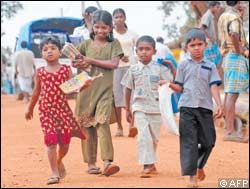 The aerial view of Manik Farm refugee camp from the military helicopter is bleak – a series of tin and thatch barracks surrounded by razor wire and closely guarded by soldiers.
The aerial view of Manik Farm refugee camp from the military helicopter is bleak – a series of tin and thatch barracks surrounded by razor wire and closely guarded by soldiers.
But on the ground the camp – which was opened a few months ago in Vavuniya, north Sri Lanka, to house thousands of refugees fleeing the island’s civil war between the government and ethnic Tamil rebels – is bustling.
School is under way in makeshift classrooms under trees; lessons include Tamil Carnatic classical music. Nearby, residents prepare to celebrate a Hindu festival while others visit new shops and an Ayurvedic medicine clinic.
With the government on the cusp of victory in its 25-year war against the Liberation Tigers of Tamil Eelam, Manik Farm “welfare camp” is designed to mark the next phase in the conflict – the war for the hearts and minds of the Tamil people, for whom the rebels have for decades claimed to be the sole representatives.
Outlawed in the west and India as a terrorist organisation, the LTTE once occupied most of north and eastern Sri Lanka in its quest for an independent Tamil homeland free from the domination of Sri Lanka’s ethnic Sinhalese Buddhist majority.
But since a ceasefire broke down in 2006, the rebels have gradually been driven into an 87 sq km pocket, in an area known as “the Wanni” in the island’s remote north-east. The cadres have herded with them into the pocket up to 250,000 civilians, according to estimates from aid agencies.
With the Tigers believed to be making their last stand, the fate of these trapped civilians has become a matter of international concern – nowhere more so than in India, the regional power which has its own large population of Tamils.
At Manik Farm, most of the 2,800 camp residents tell horror stories about escaping from the LTTE.
Devi Segaram said her daughter was forced to hide at a Catholic orphanage in Mannar, the southern part of the rebel-held territory, to avoid recruitment by the LTTE.
As the frontline shifted north, Ms Segaram, an English teacher, and her daughter were also forced to move. Over two years they were displaced 10 times until, on February 6, they and about 1,000 others fled in darkness towards the military frontline.
“It was very bad. They [the Tigers] were firing as we were running,” she said. Two young boys were killed.
Such traumatic stories are commonplace at Manik Farm. Aid workers there say the most pressing medical problem they confront is mental illness.
For Ms Segaram, Manik Farm represents safety. But many residents are becoming disgruntled. “It’s an open jail,” said one man.
The military presence is heavy, with residents screened to detect any LTTE “infiltrators”. The camp’s residents are not allowed outside the perimeter fence, visitors are prohibited and there is no telephone link with the outside world.
“It is not a detention. We are keeping them in the safest area,” P.S.M Charles, the government agent for Vavuniya, told a press conference at the camp.
As Ms Charles was leaving, a group of camp inmates approached her. Two years ago, during the last ceasefire in the war, they had returned to their homes near Kilinochchi, the former rebel capital, from their university studies in government-held Jaffna for a break.
When hostilities suddenly resumed they became stranded in LTTE territory. They evaded rebel conscription by hiding in the jungle. Now they are stuck at Manik Farm and want to return to their studies.
“Don’t worry, we will send you,” Ms Charles says, patting one student on the cheek. The students return to their huts looking discouraged. Most believe it will be months, if not years, before many of the people in this camp return home.
(For updates you can share with your friends, follow TNN on Facebook and Twitter )
